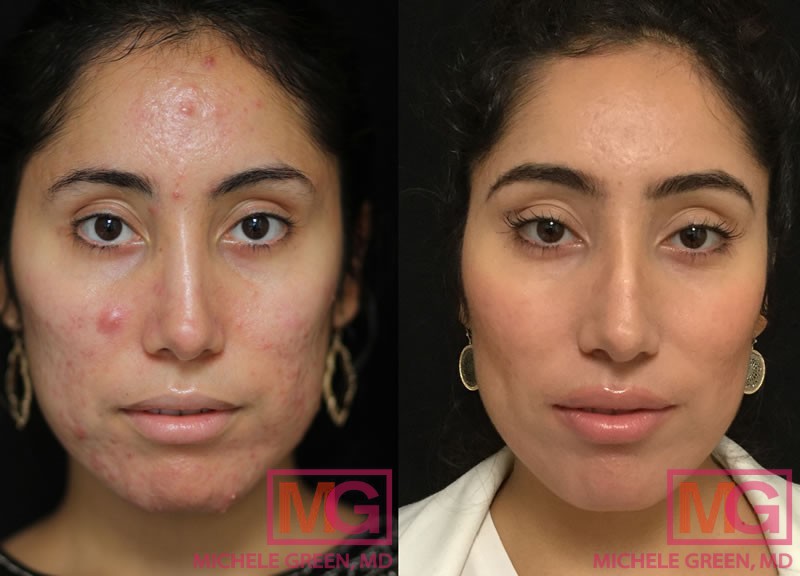Acne Vulgaris Treatment
Acne vulgaris is one of the most common skin conditions, annually affecting as many as 50 million people in the United States, according to the American Academy of Dermatology. Acne vulgaris, the scientific name for the condition that is colloquially referred to as “acne,” often affects adolescents but can be experienced by patients of any age. Patients may be affected by many types of acne, including non-inflammatory blackheads and whiteheads and inflammatory papules, pustules, nodules, and cysts. Characterized by small blemishes that can be red, painful, and inflamed, acne vulgaris can cause patients physical discomfort and feelings of frustration and low self-esteem, leading many to search for the best acne vulgaris treatment. Board-certified dermatologist Dr. Michele Green in New York City has over 25 years of experience treating patients with acne vulgaris breakouts and can create a customized treatment plan to help manage and eliminate your acne vulgaris.
There are many different causes for acne vulgaris development, including genetics, hormonal fluctuations, stress, diet, environmental factors, and skincare regimens. Understanding the cause of your acne breakouts is crucial to treating and eliminating acne vulgaris breakouts. Often, the best approach to treating acne vulgaris breakouts is a combination of in-office treatments, oral medications, and topical therapies. With many treatment options available, it can be challenging to know what the right treatments are for your specific type and severity of acne vulgaris breakouts. The first step in finding the best acne therapy for you is to schedule a consultation appointment with expert board-certified dermatologist Dr. Green. Dr. Green will first assess your medical history and skin concerns to recommend the best acne vulgaris treatments suited to help you achieve clear, acne-free skin.
Dr. Michele Green is an internationally renowned board-certified dermatologist with over two and a half decades of experience providing some of the world’s most discerning individuals with the best non-invasive treatment options for an array of cosmetic concerns and medical skin conditions, including acne vulgaris. Dr. Green takes a holistic approach to acne treatment and is a master at incorporating a combination of non-invasive cosmetic procedures, topical therapies, and oral acne medications into her patients’ individualized treatment plans that will provide them with clear, smooth, blemish-free skin that lasts. She is consistently identified as one of New York City’s best dermatologists by Super Doctors, Castle Connolly, New York Magazine, and The New York Times for her dedication to her patients and expertise.
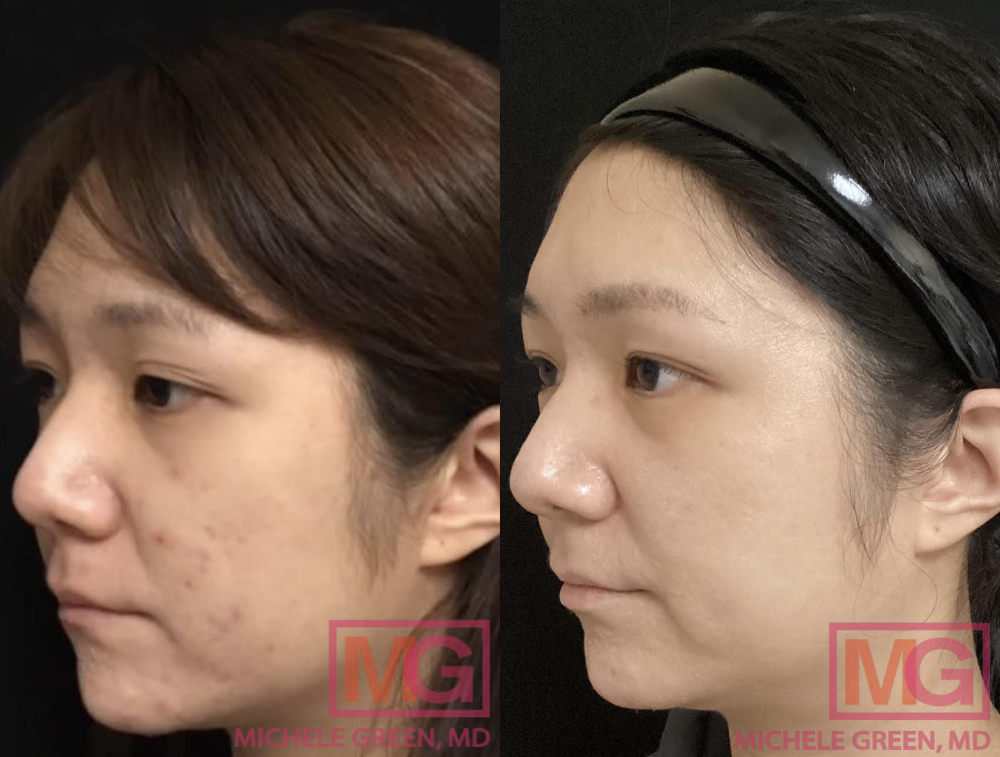
What is acne vulgaris?
Acne vulgaris is the scientific name for the skin condition commonly referred to as acne. It is one of the most common skin conditions worldwide. Acne vulgaris occurs when the oil glands in the skin’s pores become clogged with excess sebum, dead skin cells, and other debris. Within the pores, bacteria can become trapped and rapidly multiply, leading to swelling, redness, tenderness, and irritation associated with a pimple. Acne vulgaris is commonly associated with adolescents but can occur in patients of any age. Acne is most commonly found on highly visible areas of the body, such as the forehead, chin, nose, upper back, and shoulders; however, lesions can develop anywhere oil glands are present. Acne can be caused by a combination of factors, including genetics, hormones, diet, stress, hygiene, skincare, environment, and even as a side effect of certain medications. Untreated or incorrectly treated acne, whether a single cyst or a persistent breakout of whiteheads, can have long-lasting ramifications, including permanent scarring (acne scars) and hyperpigmentation. A board-certified healthcare professional, such as board-certified dermatologist Dr. Green, can work with you to determine the underlying factors contributing to your breakouts and develop a personalized plan for addressing them.
What are the different types of acne vulgaris?
Acne vulgaris lesions can be classified into two different categories: non-inflammatory and inflammatory. Non-inflammatory acne lesions are mild types of acne that are not associated with any pain, swelling, or bacterial infection. Inflammatory acne lesions are moderate to severe types of acne that are associated with pain, tenderness, and scarring. Inflammatory lesions create irreparable damage to underlying skin tissue, resulting in acne scar development. Non-inflammatory acne lesions include comedones, or blackheads and whiteheads, while inflammatory lesions include papules, pustules, nodules, and cysts.
Non-inflammatory acne lesions
- Closed comedones, also known as whiteheads, are characterized by skin-colored bumps that form due to clogged hair follicles. The contents inside the pores do not have any exposure to air and are closed underneath the skin.
- Open comedones, also known as blackheads, are characterized by clogged pores with an opening at the skin’s surface. The exposure to the air oxidizes the sebum, dead skin cells, and debris in the pores, resulting in a characteristic black appearance.
Inflammatory acne lesions
- Papules are inflammatory lesions that form when a clogged hair follicle becomes inflamed. They appear as small red bumps that may be tender to the touch.
- Pustules are similar to papules but differ in that they are filled with pus due to a buildup of white blood cells. It is essential not to pick at or pop pimples, as the pus that is released may spread to other pores, leading to further infection.
- Nodules are acne lesions that form when bacteria are trapped beneath the skin’s surface. They form a hard lump that is painful to the touch. Nodular acne has a high risk of resulting in acne scarring following the infection.
- Cysts occur when nodular acne is filled with bacteria and pus. Similar to nodular acne, cystic acne extends deep under the skin’s surface. Cystic acne is considered to be the most severe form of acne due to its ability to create permanent tissue damage and scarring.
What is the main cause of acne vulgaris?
Acne vulgaris occurs when pores and hair follicles become clogged with excess oil, dead skin cells, and other debris. Naturally occurring skin bacteria can also become trapped in the pores, where they multiply, leading to irritation, inflammation, and tenderness that is characteristic of a pimple. There are several risk factors for developing acne vulgaris. Some patients have a genetic predisposition to developing acne due to increased sebaceous glands or higher levels of sebum production. Many patients experiencing acne vulgaris also have a family history of acne breakouts. Hormone changes, such as those during puberty, the menstrual cycle, pregnancy, and menopause, play a large role in acne vulgaris development. Androgen hormones, or male sex hormones like testosterone, can increase sebum production and increase the risk of acne breakouts. Diets with high glycemic index foods, poor hygiene, and stress can also cause acne vulgaris breakouts. Some patients want to know which vitamin deficiency causes acne vulgaris — while not every individual with a vitamin deficiency will develop acne breakouts, deficiencies in vitamins A, B, D, and E can all potentially cause acne breakouts.
The safest, fastest, most effective way to determine the cause of your acne vulgaris breakouts is to consult a board-certified dermatologist like Dr. Green. When you consult with Dr. Green at her private dermatology office in Manhattan’s Upper East Side neighborhood, she will physically evaluate your skin condition, collect a thorough medical and family history, and potentially order certain blood tests for laboratory evaluation. Depending on your consultation, Dr. Green will recommend a unique combination of topical treatments, oral medications, and in-office procedures to treat your existing acne and prevent new breakouts, resulting in a smooth, clear, healthy complexion.
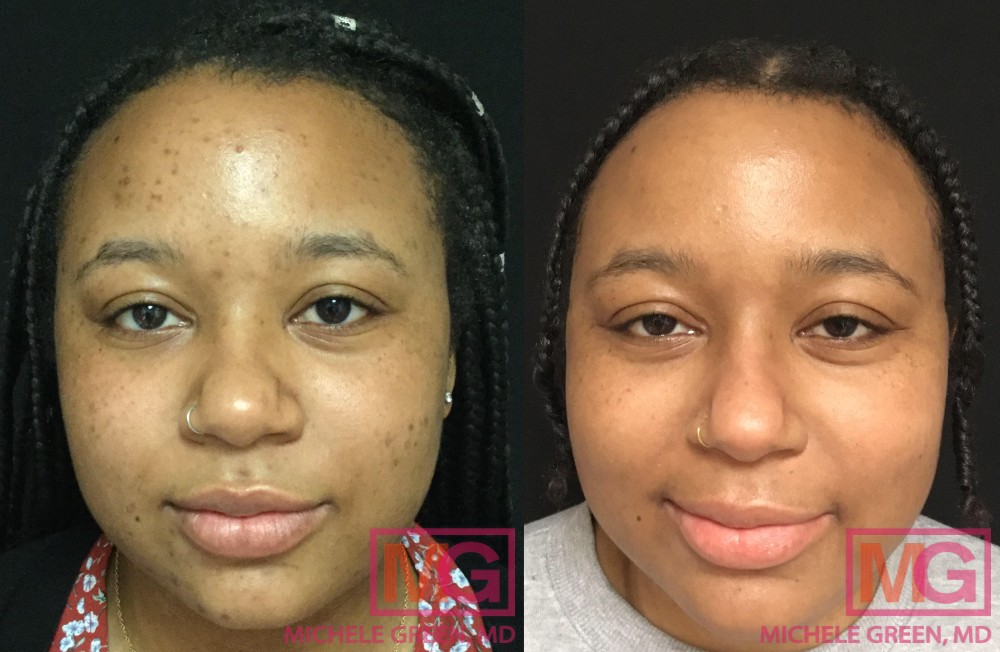
Is acne vulgaris fungal or bacterial?
Acne can be fungal or bacterial. The most common form of acne is bacterial, caused by the bacteria Cutibacterium acne (C. acnes). C. acnes is naturally found on the skin’s surface; however, C. acnes trapped in pores or hair follicles, along with sebum, dead skin cells, and debris, can result in bacterial proliferation, inflammation, and moderate-to-severe acne lesions such as papules, pustules, nodules, and cysts. Fungal acne is caused by an overgrowth of Malassezia yeast on the skin, another substance naturally occurring on the skin. Yeast and bacteria levels on the skin’s surface are typically maintained to balance each other out. When yeast production is far greater than bacteria, a yeast infection in pores can result in fungal acne breakouts. Yeast production can be accelerated in warm, oily, moist environments. During your assessment of your acne breakouts, a culture can be taken to diagnose if your breakouts are a result of a fungal or bacterial infection.
When should you consult a dermatologist for acne vulgaris treatment?
It is essential to consult a dermatologist as soon as an acne vulgaris breakout occurs. When left untreated, acne lesions, particularly non-inflammatory acne lesions, can result in inflammation, tissue damage, and scarring. Acne scars are permanent and are often harder to treat than the acne breakouts themselves. According to the American Academy of Dermatology’s “Guidelines of Care for the Management of Acne Vulgaris” (J Am Acad Dermatol. May 2016;74(5):945–973.e33), the best approach for eliminating acne vulgaris is typically a customized combination approach, meaning combining various forms of topical and oral therapies that each treat different acne pathogenesis (factors that lead to acne breakouts). If you have acne lesions that do not respond to over-the-counter treatments, it is best to consult with a board-certified dermatologist like Dr. Green. She will first assess your medical history and skin concerns and order blood tests to determine if there is any underlying factor causing your breakouts. She will then tailor a treatment plan fitted with in-office treatments, oral medications, and topical creams to help you clear your acne for good.
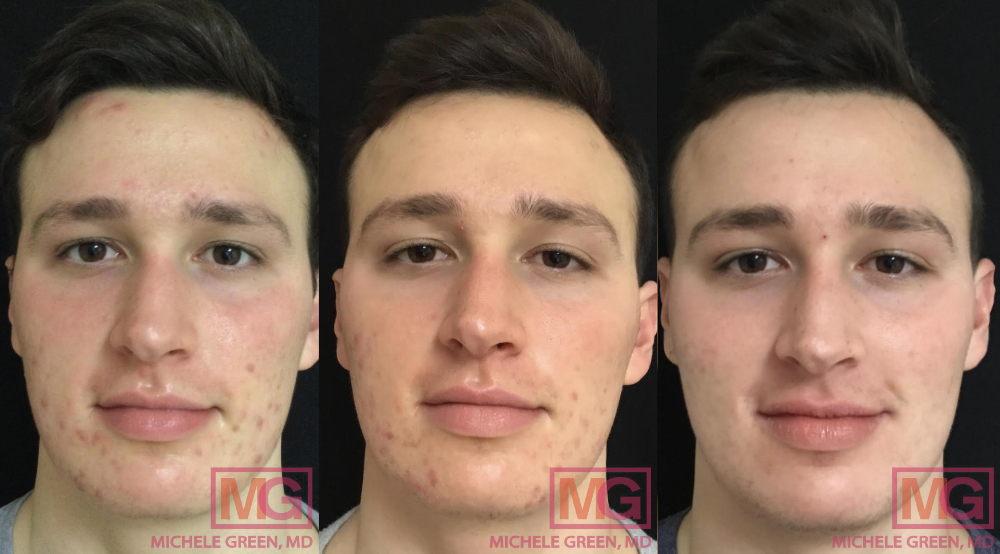
In-office Treatments for Acne Vulgaris
Acne surgery
Acne surgery is a highly effective procedure for treating painful inflammatory lesions such as pustules, papules, and cysts. During the procedure, the acne lesions are opened, and the dead skin cells, sebum, and dirt trapped inside the pore are removed. A steroid is then injected into the lesion to shrink the lesion, accelerate healing, and prevent the development of any acne scarring. If the acne cyst is very large, the cyst must be drained first before injection of the corticosteroid. With no downtime, acne surgery is an excellent treatment option for reducing acne breakouts.
VBeam Laser
The VBeam laser is a non-invasive pulsed dye laser that can treat acne breakouts as well as pigmented acne scars. The VBeam laser uses a 595nm wavelength to eliminate red pigmentation, inflammation, and acne-causing bacteria. In addition to treating acne and acne breakouts, the VBeam laser treats broken capillaries, rosacea, red stretch marks, and post-inflammatory hyperpigmentation. There is no downtime associated with the procedure, and patients can resume their daily activities afterward. Patients often need a series of treatments, each spaced one month apart, to achieve the best cosmetic results.
Chemical peels
Chemical peels work to gently exfoliate the skin, removing dead skin cells, debris, and sebum from clogged pores. The chemical exfoliants used during the procedure also kill acne-causing bacteria, reducing the risk of acne vulgaris breakouts. Dr. Green typically uses trichloroacetic acid (TCA) during chemical peels for acne, as it helps to stimulate skin cell turnover and keep pores clear. TCA peels can also improve skin texture and tone for a more rejuvenated appearance. Dr. Green may recommend four to six chemical peels depending on the type and severity of your acne.
HydraFacials
A HydraFacial is a multi-step treatment that gently cleanses, exfoliates, and nourishes the skin. The first step involves removing any superficial impurities found on the skin’s surface. The second step utilizes salicylic and glycolic acid, two hydroxy acids, to break apart dirt, dead skin cells, and sebum in clogged pores to exfoliate the skin. The last step involves hydrating and soothing the skin with a blend of hyaluronic acid and peptides. A HydraFacial can also be enhanced with personalized boosters based on specific skin concerns. The Murad Clarifying Booster is an excellent addition for the treatment of acne breakouts, as it contains salicylic acid to create a deeper cleanse of the skin and green tea extract to soothe redness and irritation. The ZO Rozatrol Booster is also excellent for acne vulgaris, containing rosa canina extract and lactose to reduce redness and inflammation. Additionally, red LED light can be used to reduce redness further, while blue LED light can be used to kill acne-causing bacteria on the skin’s surface.
Oral medications for acne vulgaris
Oral antibiotics can be prescribed for moderate-to-severe cases of acne vulgaris to reduce the prevalence of acne-causing bacteria on the skin’s surface and eliminate acne vulgaris. The most common antibiotics prescribed for acne vulgaris include doxycycline, tetracycline, and minocycline. Oral antibiotics are excellent for treating acne vulgaris breakouts, but they are not meant to be used long-term. Proper sun protection is essential when using an oral antibiotic, as it increases the skin’s sensitivity to the sun.
Women experiencing acne vulgaris due to hormonal fluctuations and polycystic ovarian syndrome (PCOS) can benefit from using Spironolactone or oral contraceptives. Spironolactone is an anti-androgen medication that regulates androgen or male hormone levels to reduce acne breakouts. Oral contraceptives help regulate hormone levels to reduce sebum production and acne vulgaris. In order to effectively treat acne, oral contraceptives must contain some form of estrogen and progesterone. Yaz, Ortho Tricyclen, and Estrostep are three FDA-approved oral contraceptives for treating acne vulgaris.
Patients with acne breakouts who do not respond to topical or oral medications can benefit from using oral isotretinoin. Isotretinoin, more commonly referred to by its brand name Accutane, is a vitamin A derivative that decreases sebum production, reduces the size of the sebaceous glands, increases the rate of skin cell turnover, and inhibits the growth of acne-causing bacteria on the skin’s surface. Other brand names of oral isotretinoin include Absorica, Amnesteem, Claravis, Myorisan, and Zenatane. Accutane is typically prescribed over a short 20-week course to treat and eliminate acne vulgaris breakouts permanently. Clinical trials with Accutane have demonstrated complete or nearly complete cessation of acne breakouts after therapy. Roughly 95% of patients who take Accutane find that their acne vulgaris breakouts do not come back. The remaining 5% of patients can undergo a second course of Accutane to get rid of their breakouts permanently. The most common adverse effects of Accutane include dry skin, lips, and eyes. As the FDA regulates Accutane prescriptions, patients must have monthly visits and bloodwork tests before the medication can be prescribed. As Accutane can cause severe congenital disabilities if taken while pregnant, patients who can become pregnant must additionally have monthly pregnancy tests and pledge to either abstinence or two forms of birth control.
Prescription topicals to treat acne vulgaris
Topical retinoids, which are derivatives of vitamin A, have been used to treat acne vulgaris for more than 30 years and are highly effective at reducing inflammation and follicular clogging. Retinoids work to accelerate skin cell turnover, exfoliating the skin to remove buildup in pores. Many formulations of topical retinoids are available, including tretinoin, adapalene, dapsone, and tazarotene. Retinoids should only be used at night and while practicing proper sun protection, as they can make the skin more sensitive to the sun. Topical antibiotics manage acne breakouts by eliminating the bacteria responsible for acne vulgaris and reducing inflammation. The most common topical antibiotics prescribed for treating acne vulgaris are erythromycin and clindamycin, which are commonly found in concentrations of 1-4%. Winlevi is a topical treatment containing clascoterone, an androgen inhibitor that blocks the skin’s hormones from producing too much oil. By preventing the production of excess sebum, Winlevi helps keep pores clear and prevents and treats active acne breakouts. It is suitable for both males and females aged twelve and older.
What is the best skincare regimen for acne vulgaris?
Utilizing a proper skincare regimen is essential to managing acne vulgaris and preventing the formation of new acne lesions. Board-certified dermatologist Dr. Michele Green’s proprietary skincare line, MGSKINLABs, contains an Acne Kit designed to manage acne breakouts effectively. The Pore Minimizing Cleanser uses glycolic and salicylic acid to gently exfoliate the skin, unclog pores, and minimize the appearance of enlarged pores. The Retexturizing Pads also contain glycolic and salicylic acid to cleanse the skin further and soften skin texture. Lastly, the Acne Spot Treatment contains 5% benzoyl peroxide to kill acne-causing bacteria, dry out acne lesions, and reduce inflammation.
Differin gel is an excellent over-the-counter exfoliant containing adapalene. In addition to increasing skin cell turnover, using Differin gel regularly can help reduce the buildup of dead skin cells and sebum, prevent the formation of new acne lesions, and improve skin texture and tone. Moisturizer is an essential step of any skincare routine, as it helps to hydrate the skin and protect the skin’s natural moisture barrier. The best moisturizers for acne-prone skin are non-comedogenic ones, meaning they will not clog pores. The Ultimately Sheer Lotion from MGSKINLABs contains glycerin and the lipid squalane to hydrate the skin, as well as green tea extract to soothe inflamed skin. Sunscreen is incredibly important in any skincare regimen to protect the skin from harmful UV rays. For maximum sun protection, patients should use a broad-spectrum sunscreen with an SPF of 50. MGSKINLAB’s Hydrating SPF 50 contains zinc oxide to create a barrier against UV rays and hyaluronic acid to nourish the skin.
Will my acne vulgaris go away on its own?
Acne vulgaris is a skin disease characterized by dead skin cells, sebum, debris, and bacteria trapped in clogged pores. Acne vulgaris often develops in adolescence but can affect patients of any age. While some patients may be able to resolve their breakouts with over-the-counter products, including salicylic acid, azelaic acid, or benzoyl peroxide, most patients require some form of medical intervention to get rid of their acne completely. Acne medications and treatments target the factors that cause acne breakouts, such as excess sebum production, high concentrations of bacteria on the skin’s surface, inflammation, and clogged pores. These therapies can take time to work fully, meaning patients will see results after several weeks or several months of treatment. If you are experiencing chronic acne, the best course of action is to schedule a consultation appointment with board-certified dermatologist Dr. Michele Green to determine the treatment plan to help you get rid of your acne vulgaris and achieve clear, healthy skin.
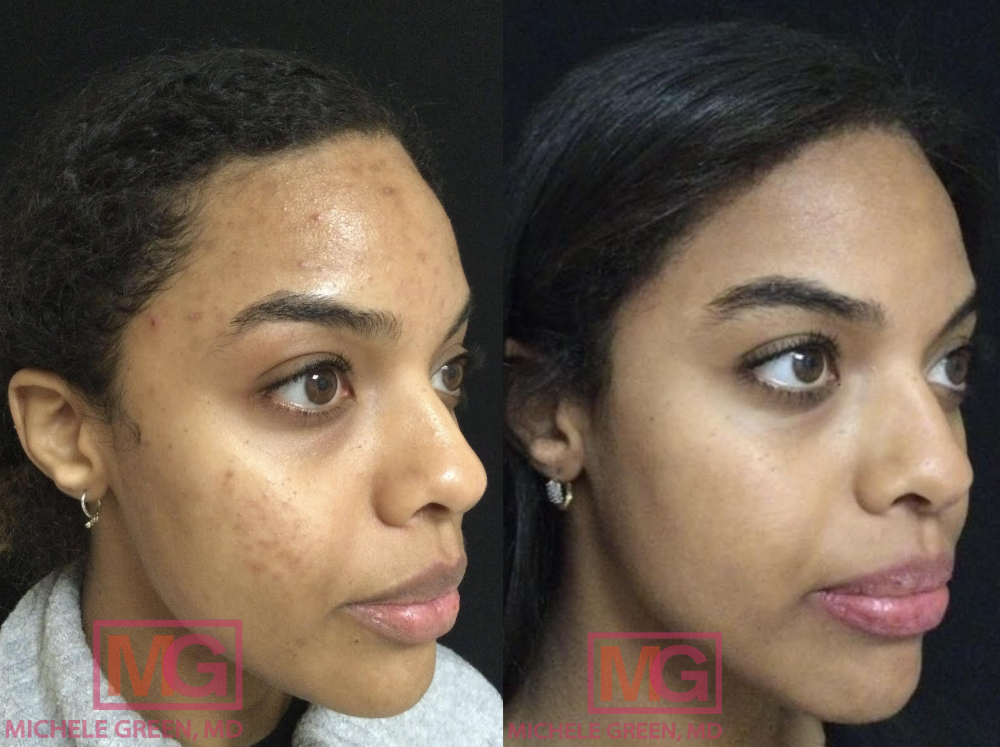
Frequently Asked Questions about Acne Vulgaris:
What is acne vulgaris vs acne?
Acne vulgaris is the medical term for the skin condition that we commonly refer to as acne. Within the broader term acne vulgaris, there are several types of acne, including open and closed comedones, papules, pustules, cysts, and nodular acne. The treatment method will change depending on the type of acne present on the skin, which is why it is essential to consult with a board-certified dermatologist when creating your treatment plan.
What is the most common type of acne?
The most common type of acne is comedonal acne, also referred to as whiteheads and blackheads. Comedonal acne forms when pores are clogged with dead skin cells, debris, and other impurities. Whiteheads are comedonal acne lesions that are covered with skin, creating the appearance of a skin-colored bump. Blackheads are comedonal acne lesions with an opening of the skin’s surface, resulting in oxidation of the pore’s contents and the appearance of a dark, black bump.
What are the four stages of acne vulgaris?
Dermatologists can classify acne vulgaris into four different stages or grades based on the severity of the breakouts. Stage 1 is mild acne vulgaris characterized by mostly comedonal acne and few papules or pustules. Stage 2 is moderate or pustular acne vulgaris characterized by multiple papules and pustules in addition to blackheads and whiteheads. Stage 3 is moderately severe or nodulocystic acne vulgaris characterized by numerous papules and pustules. Several inflamed nodules or cysts may develop and may also extend to the back or chest. Stage 4 is severe nodulocystic acne vulgaris characterized by numerous eruptions of inflamed nodular or cystic acne lesions.
What age is acne vulgaris the worst?
Acne vulgaris typically occurs most severely during adolescence due to hormone fluctuations associated with puberty. However, it can affect men and women of all ages and to different degrees.
Can other conditions appear as acne vulgaris?
Yes! One skin disorder commonly mistaken for acne vulgaris is acne rosacea. Rosacea is a chronic inflammatory skin condition characterized by facial redness, flushing, and broken blood vessels. Patients with rosacea can also develop acne rosacea, which appears as pimples and pustules. While acne rosacea looks similar to acne vulgaris, they are not the same. The exact cause of acne rosacea is unknown, although there may be environmental or biological risk factors that can trigger a breakout. Acne vulgaris, however, is formed when pores are clogged with sebum, dead skin cells, debris, and, in cases of inflammatory acne, bacteria. Acne rosacea is often accompanied by visible signs of rosacea, such as diffuse redness and facial telangiectasia. Another skin disorder often mistaken for acne vulgaris is perioral dermatitis. This disorder is characterized by skin inflammation and irritation around the mouth. It can appear as a bumpy, red, scaly rash that is often itchy. Lifestyle habits, topical or inhaled steroid use, or biological factors can trigger perioral dermatitis. If you are experiencing red bumps on your face that may look like acne breakouts, consult with a board-certified dermatologist like Dr. Green. As acne vulgaris can appear similarly to acne rosacea, perioral dermatitis, and other skin conditions, a proper diagnosis is crucial to ensuring that you are using the correct treatments for your skin concerns.
Why did I get acne vulgaris?
Acne vulgaris occurs when the pores become clogged with oil, dead skin cells, and debris, leading to red bumps on the skin’s surface. Several risk factors can lead to the continued prevalence of acne vulgaris, including:
- Changes in hormone levels associated with puberty, menstruation, pregnancy, or menopause
- Medications such as corticosteroids, lithium, or testosterone
- Family history of acne breakouts
- A diet that is high in carbohydrates, sugars, and dairy
- Chronic stress
- Improper hygiene, such as not washing with soap or cleanser after exercising
When you consult with Dr. Green in her private NYC dermatology office, she will first assess your medical history and skin concerns. She may order blood tests to determine if any underlying factors may be causing the acne breakouts. Afterward, she will be able to create a customized acne vulgaris treatment plan to help you eliminate your breakouts for good and achieve clear, smooth skin.
What kills acne vulgaris?
Various topical and in-office treatments can eliminate and kill the bacteria on the skin’s surface that contribute to acne vulgaris breakouts. Topical antibiotics such as erythromycin and clindamycin actively work to reduce levels of C. acne and treat mild acne vulgaris. Oral antibiotics such as doxycycline or tetracycline can also be used to eliminate acne-causing bacteria and clear acne breakouts. For severe or recalcitrant acne that does not respond to topical or oral medications, Accutane can be prescribed to treat and eliminate acne for good. In addition to killing acne-causing bacteria, Accutane also shrinks sebaceous glands, decreases sebum production, and increases the rate of skin cell turnover.
What is the strongest natural antibiotic for acne?
Some natural antibiotics that can help acne breakouts include honey, tea tree oil, and sulfur. These ingredients contain antibacterial properties that can potentially have acne-fighting abilities. However, natural remedies are not always effective or safe to use, and it is important to consult with a board-certified dermatologist like Dr. Green before applying anything new to the skin. Honey-based products can help reduce redness associated with acne, but their antibacterial properties often do not protect against acne-causing bacteria like C. acnes. Some clinical studies support the treatment of mild acne with tea tree oil; however, it is essential to dilute tea tree oil and never apply it directly to the skin, as it can cause irritation and burning, especially in patients with sensitive skin. Instead of trying home remedies that can lead to irritation and worsening of acne breakouts, it is best to consult with Dr. Green to get the right treatment options for your specific skin concerns and acne breakouts.
What not to do with acne vulgaris?
Certain precautions should be taken to avoid exacerbating acne vulgaris breakouts. Patients should avoid using harsh exfoliants or scrubs when cleansing the skin, as this can result in dryness, irritation, and worsening of acne. Oily skincare products should not be used to avoid clogged pores and the development of new acne lesions. Skincare products for acne-prone skin should be oil-free and labeled non-comedogenic, meaning they will not clog pores. Patients with acne vulgaris should not stay in sweaty clothes for a long time after working out, as sweat trapped between workout clothing and skin can clog pores, trap oil, debris, and bacteria, and result in acne breakouts. Instead, patients should take off sweaty clothes and cleanse the skin as soon as possible to prevent the formation of new acne. It is also critical not to “pop” or squeeze acne breakouts as this can cause scarring.
Can you pop acne vulgaris?
No! An acne vulgaris lesion should never be popped or picked at, as the pus and bacteria trapped inside can spread on the skin and infect other clogged pores. Popping a pimple can also damage the skin tissue and create an acne scar, which is often harder to treat than the acne lesion itself. The best thing to do when experiencing acne vulgaris is to consult with Dr. Green in her private boutique dermatology office in New York City. There, she will assess your skin and medical history and order any necessary lab tests to determine factors that can be contributing to your acne vulgaris. She will then customize an acne vulgaris treatment plan with in-office treatments, topical and oral medications, and targeted skincare products to help eliminate your acne for good.
Can acne vulgaris cause scars?
Yes, acne vulgaris can cause scars on the skin. More specifically, inflammatory acne lesions like papules, pustules, nodules, and cysts can cause irreparable damage to underlying skin tissue, often creating permanent acne scars. Acne scars can appear as depressed indentations called atrophic scars or raised growths called hypertrophic or keloid scars. Atrophic scars develop when insufficient collagen is produced during the wound-healing process, while hypertrophic scars develop when collagen is over-produced during the wound-healing process. Acne scars are often harder to treat than the initial acne lesion itself, which is why it is essential to consult with Dr. Green as soon as an acne vulgaris breakout occurs. While it may not be possible to get rid of acne scars completely, Dr. Green offers various non-invasive cosmetic procedures to help reduce the appearance of acne scars.
Resurfacing lasers such as the Fraxel Laser and eMatrix Laser are excellent for stimulating collagen production and improving skin texture. Microneedling, also known as collagen induction therapy, can produce new collagen, soften the appearance of depressed acne scars and fine lines, and even out skin tone. Dermal fillers like Juvederm, Restylane, and Sculptra can be injected into the skin to replenish lost volume as a result of acne scarring. For some patients, acne scarring can also result in post-inflammatory hyperpigmentation, which appears as red or dark marks on the skin. Red acne scars can be treated with the VBeam laser, while dark marks can be treated with chemical peels like TCA peels or Mesopeels. Keloids or hypertrophic scars can be injected with a corticosteroid to shrink and flatten the scars. Patients can have many different types of acne scars on their skin, and it often takes a combination of different treatments to treat acne scars fully. However, once your acne vulgaris breakouts are eliminated, Dr. Green will be able to devise a customized acne scar treatment plan to eliminate your acne scars and create clear, radiant skin that lasts.
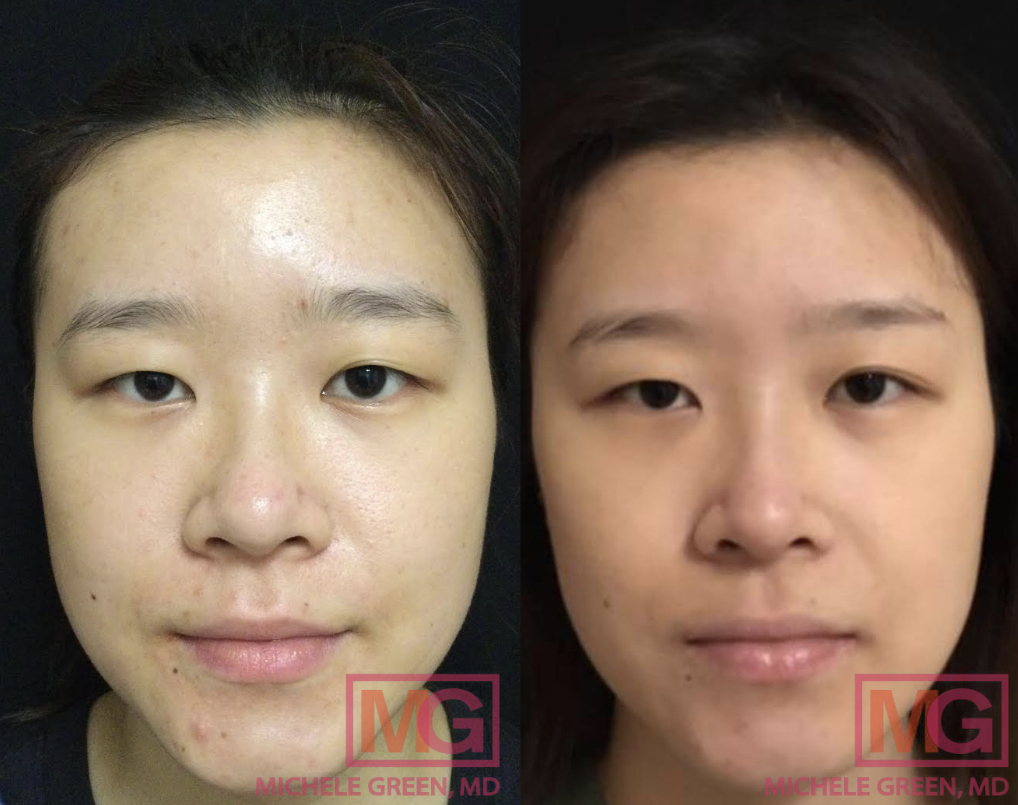
How to get started with acne vulgaris treatment today
Acne vulgaris is a skin condition that affects as many as 50 million Americans annually, making it one of the most common skin disorders in the US. Acne vulgaris breakouts are typically associated with adolescence, though they can persist or develop well into adulthood. While some individuals are able to keep acne breakouts at bay with over-the-counter products, many find that their skincare routines are not enough to prevent and manage acne vulgaris. Luckily, many professional treatment options are available at Dr. Green’s private dermatology office, including topical treatments, oral medications, and in-office treatments. Research has shown that the best way to combat acne vulgaris is to take a combination approach, utilizing various topical and oral therapies along with dermatological procedures to achieve smooth, clear, bright skin that lasts. With many treatment options to choose from, it can be difficult to know which treatments will be best for you, which is why the best first step for the treatment of acne vulgaris is to schedule an appointment with expert dermatologist Dr. Michele Green.
Dr. Michele Green is an internationally renowned board-certified dermatologist with over two and a half decades of experience providing some of the world’s most discerning individuals with the best non-invasive treatment options, including acne surgery, HydraFacials, and prescription medications for acne vulgaris. Dr. Green takes a holistic approach and embraces a less-is-more philosophy, creating customized skincare routines and treatment plans that cater to the unique concerns and aesthetic goals of her patients. She is consistently identified as one of New York’s best dermatologists by Castle Connolly, New York Magazine, Super Doctors, and The New York Times for her dedication to her patients and expertise. Please call us at 212-535-3088 or email our New York City-based office today to schedule a consultation with Dr. Michele Green and get started with your personalized acne treatment.
 212-535-3088
212-535-3088 